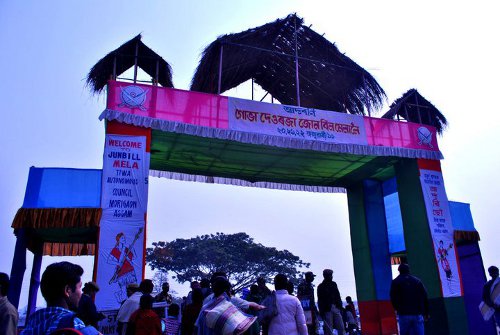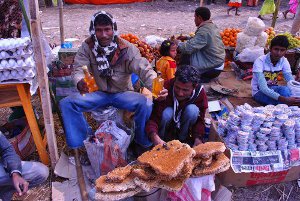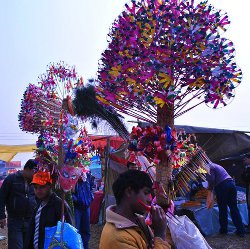Jon Beel Mela: My Virtual Journey
February 1, 2011(Photo Courtesy: Anjan Barua)
It had been a while since I had last signed in to check my mail, and when I did so after a gap of 3 days, no doubt, I found my mail box stashed with 15 or so unread messages. As I opened the first mail, my screen seemed to be hit by a splash of bright colors. A friend of mine, an amateur photographer, who has a high-end camera, and never misses a good opportunity to put his lenses to use, had sent me a number of bright and colorful photographs of his visit to the recently held Jon Beel Mela. I fell in love with the photos instantly and cursed myself for not being able to attend the fair. I immediately called him up to learn more about his experience. And what followed in the next 1 hour of the conversation sort of compensated for my absence, and it was like taking a virtual journey myself to the traditional community fair.

The Jon Beel Mela is a three day long community fair held every year in the weekend following Magh Bihu, at a place called Dayang Belguri at Jon Beel. This place lies at a distance of 5 km from Jagiroad in Morigaon district of Assam, and 32 km away from Guwahati. The place takes its name from a large crescent moon shaped water body there. The Assamese word Jon means the Moon, and the word Beel means Wetland. The Ahom Kings were the first to organize this fair way back in the 15th century itself. Ahom king Pratap Singha was the one to initiate this tradition. Ever since then, this tradition has been continuing over the centuries. This fair has now become an important tourist attraction. One interesting feature of this fair is that trade is carried out purely in the barter system.  This Jon Beel Mela is the only fair in India in which this system of exchange of goods is still alive, even today. The various communities and tribes like Khasi, Karbi, Tiwa and Jaintia living in the nearby hilly regions come to the fair with various local products of their own villages and exchange them with other products and merchandise of the local people of the valleys.
This Jon Beel Mela is the only fair in India in which this system of exchange of goods is still alive, even today. The various communities and tribes like Khasi, Karbi, Tiwa and Jaintia living in the nearby hilly regions come to the fair with various local products of their own villages and exchange them with other products and merchandise of the local people of the valleys.
This year, the fair was held on the 20th, 21st and 22nd of January. The first day began with the Community Feast in the banks of Jon Beel symbolizing the ceremonial opening of the Mela, which was attended by the Gobha King. He is the customary king of the Gobha Kingdom (the Tiwa dynasty) which includes different communities falling under the districts of Nagaon, Marigaon and Kamrup.
On the second day, the people got busy in conducting the real trade. The tribal people from the hills exchanged their agricultural products like turmeric, ginger, fresh vegetables and other food items with the traditional pitha, sira, akhoi, muri and fish of the local people of the Gobha Rajya. This system of exchanging goods actually marks the establishment of friendly ties between the people of these various communities and tribes. As time has advanced, nowadays,  alongside the barter-fair, several other stalls are also set up for the tourists as well as the people of the nearby districts. The businessmen and merchants also find a very good market for trade. Everything starting from handicrafts, furniture, clothes, food, books, and other artifacts are put up for sale, just like in any other fair. Here, instead of barter, trade is carried out with the exchange of money. My friend was particularly excited to see honey being sold along with the bee hives. Not only that, there was even a magic show being held. At that, I really felt like I have missed out a lot. The community fishing in the Beel was also a major attraction of the second day of the fair.
alongside the barter-fair, several other stalls are also set up for the tourists as well as the people of the nearby districts. The businessmen and merchants also find a very good market for trade. Everything starting from handicrafts, furniture, clothes, food, books, and other artifacts are put up for sale, just like in any other fair. Here, instead of barter, trade is carried out with the exchange of money. My friend was particularly excited to see honey being sold along with the bee hives. Not only that, there was even a magic show being held. At that, I really felt like I have missed out a lot. The community fishing in the Beel was also a major attraction of the second day of the fair.
On the third day of the Mela, the King usually comes, along with his courtiers, and as per tradition, collects tax from his subjects. The taxes can be either in the form of money or goods, according to the convenience of the people. These taxes, as well as grants from the government are used for the organization of the fair, every year. This year, the taxes were collected by the King of Dakkhin  Nagaon. After that, there were many other fun events. The last day of the fair was graced by the presence of the Governor of Meghalaya, Ranjit Shekhar Mushahari. The closing ceremony turned out to be more colorful because of the cultural function, where traditional dances were performed by the local tribes. One of the chief attractions of the cultural function was the Bagoorumba dance performed by beautiful Bodo girls. With music and dance, the atmosphere turned even more cheerful and finally the three day long fair came to an end with smiles and promises of harmony among the people of the locality.
Nagaon. After that, there were many other fun events. The last day of the fair was graced by the presence of the Governor of Meghalaya, Ranjit Shekhar Mushahari. The closing ceremony turned out to be more colorful because of the cultural function, where traditional dances were performed by the local tribes. One of the chief attractions of the cultural function was the Bagoorumba dance performed by beautiful Bodo girls. With music and dance, the atmosphere turned even more cheerful and finally the three day long fair came to an end with smiles and promises of harmony among the people of the locality.
While my friend was busy giving me a minute by minute account of the whole affair, I was making up my mind to paint a pen picture of  those three days for other people like me who could not visit the Mela. It is said that a good picture is worth a thousand words. But, here I had with me a number of lively pictures and a vivid narration of a virtual journey. The first thing I did after this was calling up my editor. And the rest is history!!!
those three days for other people like me who could not visit the Mela. It is said that a good picture is worth a thousand words. But, here I had with me a number of lively pictures and a vivid narration of a virtual journey. The first thing I did after this was calling up my editor. And the rest is history!!!
(Special Thanks to Anjan Barua, Upasana Das)
We welcome your comments at letters@friedeye.com

